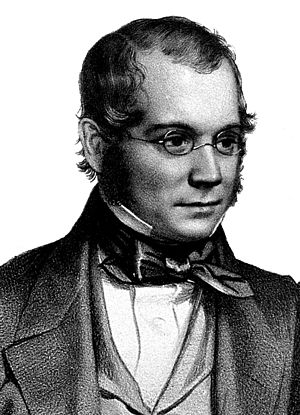David T. Ansted facts for kids
David Thomas Ansted (born February 5, 1814 – died May 13, 1880) was an important English scientist. He was a professor who studied geology, which is the science of Earth's physical structure and history. He also wrote many books about geology. Ansted taught at a special school called Addiscombe Military Seminary. Here, students learned to become officers for the East India Company. Because of his teaching, many people in different parts of the world became interested in geology.
Contents
Early Life and Learning
David Thomas Ansted was born in London on February 5, 1814. He went to Jesus College at the University of Cambridge. There, a famous geologist named Adam Sedgwick inspired him to study geology.
After finishing his studies in 1839, Ansted became a professor of geology at King's College London in 1840. He taught there until 1853.
Teaching Future Explorers
From 1845, Ansted also taught at the East India Company's Addiscombe Military Seminary. This was a special school where young men trained to become officers. His textbook, Elementary Course of Geology, was even given as a prize to students. These students later traveled to places like India and other colonies. Some of them continued to study geology because of Ansted's influence.
He also taught geology at the College for Civil Engineers in Putney.
Becoming a Respected Scientist
In 1844, Ansted became a Fellow of the Royal Society, which is a very respected group of scientists. For a few years, he was also a leader at the Geological Society of London.
Ansted became very interested in the practical side of geology. This meant using geology to solve real-world problems. He traveled to different parts of Europe, working as a consultant. He helped people understand the ground and find valuable resources as a mining engineer.
In 1870, he received a special award called the Telford Medal. He earned it for his paper about lagoons and marshes along the Mediterranean Sea.
Travels and Books
David Ansted wrote many books about geology. One of his books, Gold-Seekers Manual (1849), was written to help people who were traveling to the California gold rush. He wanted to help them find gold more easily.
Some of his other important books include:
- Geology, Introductory, Descriptive, & Practical (1844)
- The Geologist's Text-Book (1845)
- An Elementary Course of Geology, Mineralogy, and Physical Geography (1850)
- The Great Stone Book of Nature (1853)
He also wrote a book called The Channel Islands (1862) with another scientist, Robert Gordon Latham.
Discovering Coal in America
By 1853, Ansted was so well-known that investors hired him. They wanted him to explore areas in southern Virginia in the United States. He was one of the first geologists to find rich bituminous coal deposits there. These coal seams were very important for energy and industry.
Ansted also communicated with many other scientists of his time. Around 1860, he even exchanged letters with the famous scientist Charles Darwin.
Personal Life
David Ansted married Augusta Dorothea Hackett in 1848. They had six children together. Ansted passed away on May 13, 1880, in Melton, near Woodbridge. He is buried in Kensal Green Cemetery in London.
See also
- William N. Page
- Ansted, West Virginia
- Winding Gulf Coalfield


